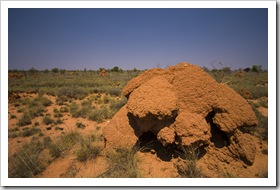
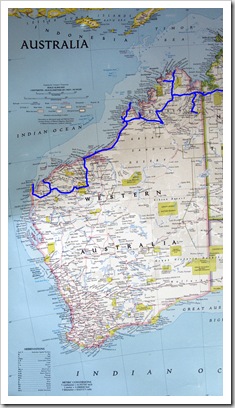 We flew from Jakarta via Singapore back to north Australian city of Darwin, where we spent the day enjoying lunch with my auntie and uncle followed by a trip to see my cousin at work with her first and second graders at Nakara Primary School. It was a fun trip, bringing back memories of the days when you could tell someone you disliked that you were going to bash them after school (I heard the threat of bashing after school twice during our visit!)… From Darwin we flew southwest to Broome to pick up The Tank, which we were very happy to see after almost two months away from our little home on wheels. From Broome it was 1869 kilometers (1160 miles) of not much more than red dirt, sand, Spinifex and no shortage of big blue skies as we drove south to Exmouth. We stopped off at a few interesting spots along the way, the first of
We flew from Jakarta via Singapore back to north Australian city of Darwin, where we spent the day enjoying lunch with my auntie and uncle followed by a trip to see my cousin at work with her first and second graders at Nakara Primary School. It was a fun trip, bringing back memories of the days when you could tell someone you disliked that you were going to bash them after school (I heard the threat of bashing after school twice during our visit!)… From Darwin we flew southwest to Broome to pick up The Tank, which we were very happy to see after almost two months away from our little home on wheels. From Broome it was 1869 kilometers (1160 miles) of not much more than red dirt, sand, Spinifex and no shortage of big blue skies as we drove south to Exmouth. We stopped off at a few interesting spots along the way, the first of 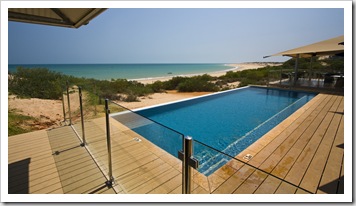 which was a small resort about an hour south of Broome called Eco Beach. The resort had been heavily advertising its existence on the TV networks when we were staying in Broome a couple of months back so we thought we should drop in and have a look-see. Tucked into the dunes 10 kilometers off the highway, Eco Beach has some beautiful stretches of coastline with everything from secluded coves to long stretches of white sand. The proprietors advertise the beaches in front of the resort as turtle nesting grounds and also boast of some of Western Australia’s best fishing in the surrounding waters. With a full-service restaurant and bar as well as a very picturesque pool, Eco Beach looks like it’d be a nice place to kick back for a few days…
which was a small resort about an hour south of Broome called Eco Beach. The resort had been heavily advertising its existence on the TV networks when we were staying in Broome a couple of months back so we thought we should drop in and have a look-see. Tucked into the dunes 10 kilometers off the highway, Eco Beach has some beautiful stretches of coastline with everything from secluded coves to long stretches of white sand. The proprietors advertise the beaches in front of the resort as turtle nesting grounds and also boast of some of Western Australia’s best fishing in the surrounding waters. With a full-service restaurant and bar as well as a very picturesque pool, Eco Beach looks like it’d be a nice place to kick back for a few days…
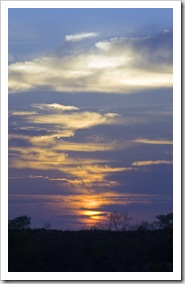
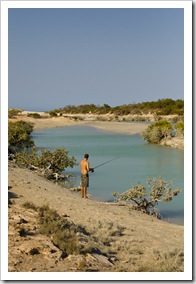
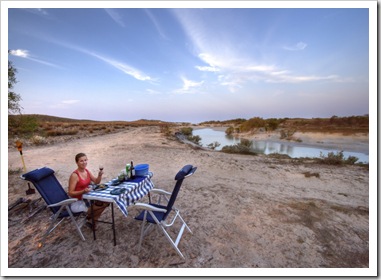 After enduring a day of gale-force headwinds along the edge of the Great Sandy Desert that pushed our fuel consumption up by around 15% we stayed a night at a secluded spit of land called Cape Keraudren (S19°58.402′ E119°47.240′), 150 kilometers northeast of Port Headland. After crossing the Martian-like salt flats between the cape and the highway we found a beautiful spot at the mouth of Cootenbrand Creek. Another chapter in our Animal Planet odyssey, the turquoise waters of the creek
After enduring a day of gale-force headwinds along the edge of the Great Sandy Desert that pushed our fuel consumption up by around 15% we stayed a night at a secluded spit of land called Cape Keraudren (S19°58.402′ E119°47.240′), 150 kilometers northeast of Port Headland. After crossing the Martian-like salt flats between the cape and the highway we found a beautiful spot at the mouth of Cootenbrand Creek. Another chapter in our Animal Planet odyssey, the turquoise waters of the creek 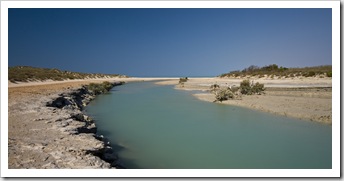
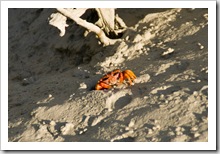 were a hive of activity in the waning afternoon sun: baitfish being chased by predatory fish and amazingly colorful orange-and-black crabs scouring the banks for a bite. The most unique of our animal experiences at Cape Keraudren would have to be the hermit crabs: as we were sitting there enjoying a glass of red wine in the dark we noticed that the moonlit ground seemed to be moving. We shone our headlamps on the sand near our feet and were amazed to see hundreds of hermit crabs making their way from Cootenbrand Creek into the surrounding bush. We had trouble making our way around the campsite without stepping on them! Never before had either of us seen such a concentration of crabs…
were a hive of activity in the waning afternoon sun: baitfish being chased by predatory fish and amazingly colorful orange-and-black crabs scouring the banks for a bite. The most unique of our animal experiences at Cape Keraudren would have to be the hermit crabs: as we were sitting there enjoying a glass of red wine in the dark we noticed that the moonlit ground seemed to be moving. We shone our headlamps on the sand near our feet and were amazed to see hundreds of hermit crabs making their way from Cootenbrand Creek into the surrounding bush. We had trouble making our way around the campsite without stepping on them! Never before had either of us seen such a concentration of crabs…
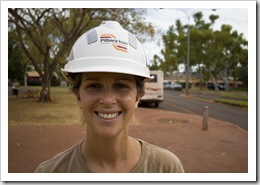 From Cape Keraudren we had a long day of driving, almost 480 kilometers (298 miles) to the majestic Karijini National Park. After refueling at Port Hedland, the massive northern Pilbara enclave of BHP Biliton’s iron ore operation, we headed south into the Spinifex covered plains toward the mining town of Newman. We were one of the few conventional vehicles on the road, road trains are the typical means of road transport in the northern Pilbara as they trek across the country to supply the massive iron ore operations dotted throughout the area. Most of them had at least three trailers, some of them we spotted with four troughs fully-laden with iron ore.
From Cape Keraudren we had a long day of driving, almost 480 kilometers (298 miles) to the majestic Karijini National Park. After refueling at Port Hedland, the massive northern Pilbara enclave of BHP Biliton’s iron ore operation, we headed south into the Spinifex covered plains toward the mining town of Newman. We were one of the few conventional vehicles on the road, road trains are the typical means of road transport in the northern Pilbara as they trek across the country to supply the massive iron ore operations dotted throughout the area. Most of them had at least three trailers, some of them we spotted with four troughs fully-laden with iron ore.
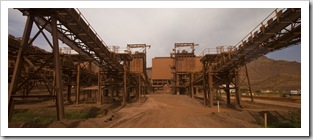 After an awe-inspiring few days in Karijini we headed to Western Australia’s highest town on the western border of the National Park: Tom Price. Tom Price is named after the American prospector who led the establishment of the iron ore industry in the Pilbara. At one
After an awe-inspiring few days in Karijini we headed to Western Australia’s highest town on the western border of the National Park: Tom Price. Tom Price is named after the American prospector who led the establishment of the iron ore industry in the Pilbara. At one 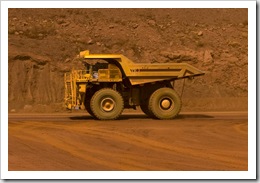 time the iron mine on the outskirts of Tom Price was the richest known deposit of iron ore on the planet. We arrived in town in time to catch the day’s mine tour, after passing all the ore road trains we both wanted to see one of the mines up close. What an
time the iron mine on the outskirts of Tom Price was the richest known deposit of iron ore on the planet. We arrived in town in time to catch the day’s mine tour, after passing all the ore road trains we both wanted to see one of the mines up close. What an 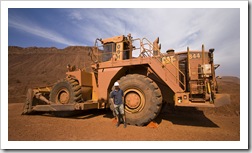
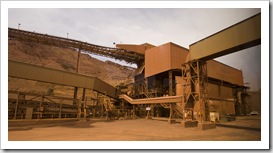 experience, here’s a few of the statistics we can remember… The Tom Price mine, owned by Rio Tinto, employs 900 full-time employees who, for the most part, work two lots of 12.5
experience, here’s a few of the statistics we can remember… The Tom Price mine, owned by Rio Tinto, employs 900 full-time employees who, for the most part, work two lots of 12.5 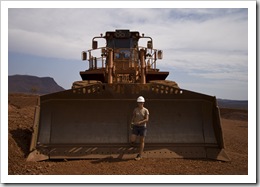 hour day shifts three days a week, followed by a day off, then three 12.5 hour night shifts followed by six days of rest. The mine pays truck and excavator drivers around $AUD100,000 per year, while train drivers earn between $AUD150,000 and $AUD180,000 per year. Employees have their housing in Tom Price heavily subsidized, company-paid private health care and allowances to fly their families in to the area from Perth during their six days off. The haul trucks (pictured above left) have 2200 horsepower
hour day shifts three days a week, followed by a day off, then three 12.5 hour night shifts followed by six days of rest. The mine pays truck and excavator drivers around $AUD100,000 per year, while train drivers earn between $AUD150,000 and $AUD180,000 per year. Employees have their housing in Tom Price heavily subsidized, company-paid private health care and allowances to fly their families in to the area from Perth during their six days off. The haul trucks (pictured above left) have 2200 horsepower 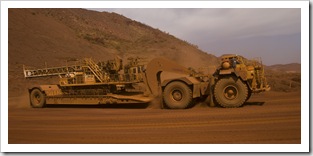 turbocharged diesel engines that run electric generators, which in turn run the drive train. The massive tires on the haul trucks measure 3.9 meters (12.9 feet) in diameters, cost $AUD100,000 each and last around eight months! The hauling trucks use approximately 20 liters of diesel per kilometer (that’s around 0.12MPG for all you North Americans) and the whole mine goes
turbocharged diesel engines that run electric generators, which in turn run the drive train. The massive tires on the haul trucks measure 3.9 meters (12.9 feet) in diameters, cost $AUD100,000 each and last around eight months! The hauling trucks use approximately 20 liters of diesel per kilometer (that’s around 0.12MPG for all you North Americans) and the whole mine goes 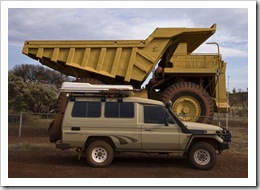 through one million liters of diesel per week! The sleds (pictured right), used for transporting some of the slower moving excavators and shovels, can carry in excess of 400 tons. The ore is moved from the Tom Price mine to the port at Dampier via train on the largest
through one million liters of diesel per week! The sleds (pictured right), used for transporting some of the slower moving excavators and shovels, can carry in excess of 400 tons. The ore is moved from the Tom Price mine to the port at Dampier via train on the largest 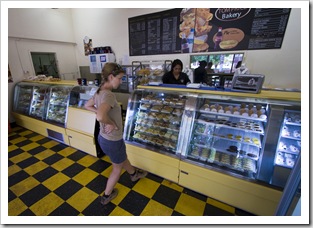 privately owned rail network in Australia, stretching over 1600 kilometers across the Pilbara. The rail system has up to 28 trains on it at any one time, each train is powered by three locomotives with combined hauling muscle in excess of 12000 horsepower, a fully laden ore train stretches approximately 2.5 kilometers. For the type of ore that can be loaded into the train using a tunnel below the ore stockpile, at current prices approximately $AUD2.3MM of ore is loaded on the train per hour. The electricity to power the mine, town, and all the other Rio Tinto mines in the Pilbara is generated in the coastal town of Dampier using natural gas mined offshore and delivered to Dampier via a 130 kilometer long underground pipeline. The Tom Price mine has only ever stopped operating once in its history: the recent recession allowed Rio Tinto to close the mine for the first time for a 10 day period this last Christmas. It was a great tour, a lot of fun to see such a gargantuan operation up close. Oh, and the bakery at Tom Price is definitely worth a visit if you find yourself in the area (Lisa had a tough time deciding in the picture to the right)!
privately owned rail network in Australia, stretching over 1600 kilometers across the Pilbara. The rail system has up to 28 trains on it at any one time, each train is powered by three locomotives with combined hauling muscle in excess of 12000 horsepower, a fully laden ore train stretches approximately 2.5 kilometers. For the type of ore that can be loaded into the train using a tunnel below the ore stockpile, at current prices approximately $AUD2.3MM of ore is loaded on the train per hour. The electricity to power the mine, town, and all the other Rio Tinto mines in the Pilbara is generated in the coastal town of Dampier using natural gas mined offshore and delivered to Dampier via a 130 kilometer long underground pipeline. The Tom Price mine has only ever stopped operating once in its history: the recent recession allowed Rio Tinto to close the mine for the first time for a 10 day period this last Christmas. It was a great tour, a lot of fun to see such a gargantuan operation up close. Oh, and the bakery at Tom Price is definitely worth a visit if you find yourself in the area (Lisa had a tough time deciding in the picture to the right)!
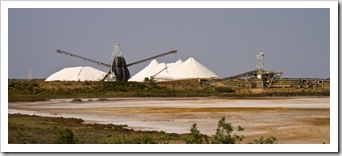
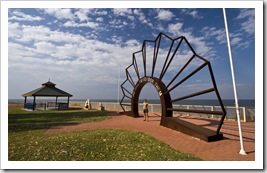 Another long day of driving took us from Tom Price to the sleepy coastal enclave of Onslow (S21°38.068′ E115°06.742′). The inhabitants of the Pilbara seem willing to mine just about anything they can find, there’s no exception in Onslow where the main industry of the isolated town is a salt mine. The extensive salt flats we passed on the way into town are harvested, refined in Onslow and then transported to ships using a huge conveyor system. Onslow’s also popular with fisherman, a few of the inhabitants of the Ocean View Caravan
Another long day of driving took us from Tom Price to the sleepy coastal enclave of Onslow (S21°38.068′ E115°06.742′). The inhabitants of the Pilbara seem willing to mine just about anything they can find, there’s no exception in Onslow where the main industry of the isolated town is a salt mine. The extensive salt flats we passed on the way into town are harvested, refined in Onslow and then transported to ships using a huge conveyor system. Onslow’s also popular with fisherman, a few of the inhabitants of the Ocean View Caravan 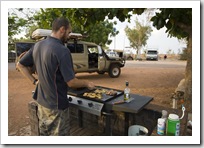 Park, where we stayed, had their fishing boats with them for their winter trips up north. We took a walk through the dunes and along the beach in the late afternoon and spent the evening at the Beadon Bay Hotel chatting with some of the locals, enjoying a few welcome draughts and getting schooled at pool like we’ve never been schooled before. Through our conversations with some of the bar staff we learned that Onslow is to be the hub for a massive Chevron-led offshore natural gas drilling project touted to deliver over $50B (yes, billion) in royalties to the Western Australian government over the next 20 years. The staff mentioned that every few days teams of engineers make their way through the otherwise sleepy town, planning the infrastructure to support the gas operation. The day before we were in Onslow a team of 10 engineers had been visiting, their task to design an international standard runway on the outskirts of town capable of handling jumbo jets. I have a feeling Onslow is going to be a busy place over the next few years…
Park, where we stayed, had their fishing boats with them for their winter trips up north. We took a walk through the dunes and along the beach in the late afternoon and spent the evening at the Beadon Bay Hotel chatting with some of the locals, enjoying a few welcome draughts and getting schooled at pool like we’ve never been schooled before. Through our conversations with some of the bar staff we learned that Onslow is to be the hub for a massive Chevron-led offshore natural gas drilling project touted to deliver over $50B (yes, billion) in royalties to the Western Australian government over the next 20 years. The staff mentioned that every few days teams of engineers make their way through the otherwise sleepy town, planning the infrastructure to support the gas operation. The day before we were in Onslow a team of 10 engineers had been visiting, their task to design an international standard runway on the outskirts of town capable of handling jumbo jets. I have a feeling Onslow is going to be a busy place over the next few years…
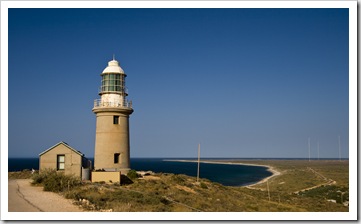
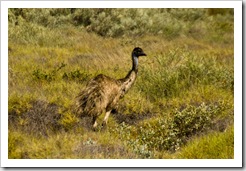 Finally to Exmouth and done with long treks for probably close to two weeks. We arrived in town around lunch time, quickly refueled and restocked, then headed to the beach for a well-deserved swim and snorkel over some of the reef for which the area is so famous. It was quite windy during our first afternoon so we ventured to one of the more protected beaches at Bundegi, the reef had some interesting fish and coral but the main attraction was a pair of lobster hiding beneath a large piece of coral about 50 meters from shore. They were without a doubt the biggest lobster either of us has ever seen, the tails on them would have easily been as thick as my thigh. Goes to show how big they can get when it’s illegal to remove them from the water (the reef at Bundegi Beach is a marine park…). Tomorrow we’re off to explore Cape Range National Park and the famous Ningaloo Reef for a few days.
Finally to Exmouth and done with long treks for probably close to two weeks. We arrived in town around lunch time, quickly refueled and restocked, then headed to the beach for a well-deserved swim and snorkel over some of the reef for which the area is so famous. It was quite windy during our first afternoon so we ventured to one of the more protected beaches at Bundegi, the reef had some interesting fish and coral but the main attraction was a pair of lobster hiding beneath a large piece of coral about 50 meters from shore. They were without a doubt the biggest lobster either of us has ever seen, the tails on them would have easily been as thick as my thigh. Goes to show how big they can get when it’s illegal to remove them from the water (the reef at Bundegi Beach is a marine park…). Tomorrow we’re off to explore Cape Range National Park and the famous Ningaloo Reef for a few days.
This entry was posted on Wednesday, October 28th, 2009 at 12:00 PM and is filed under Australia, Western Australia. You can follow any responses to this entry through the RSS 2.0 feed. Both comments and pings are currently closed.
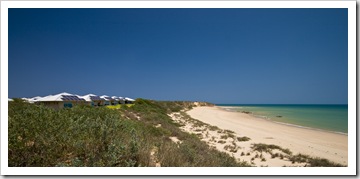
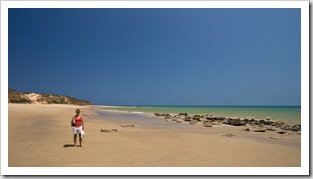
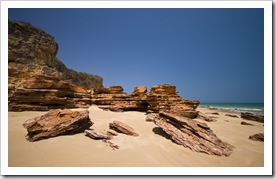
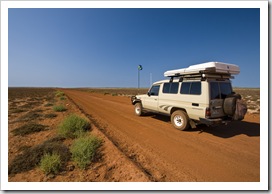
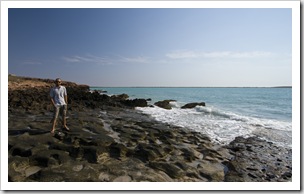
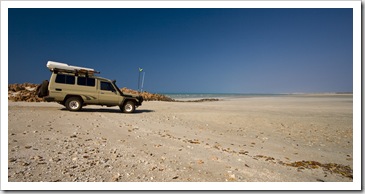
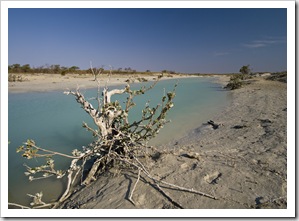
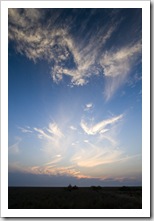
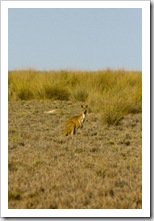
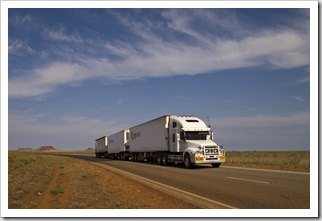
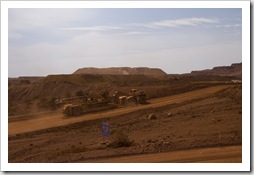
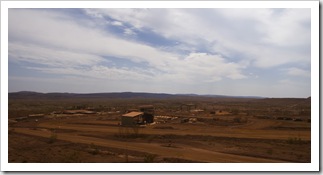
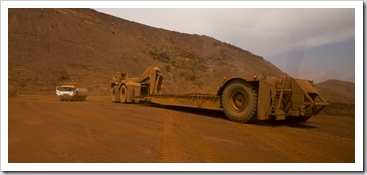
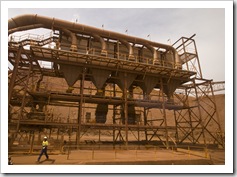
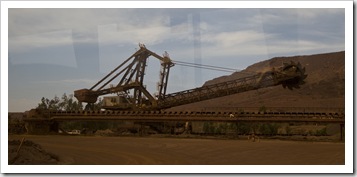
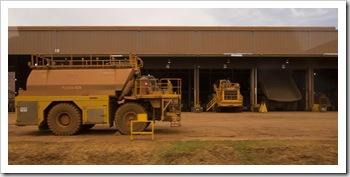
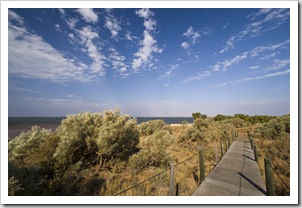
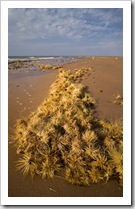
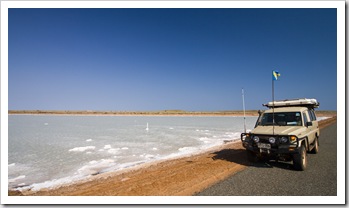
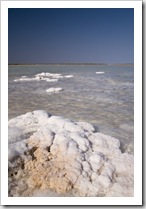

M says thanks Sam! That kid always threatens. Once he did it and was suspended for several days. A well earned holdiday for kids and teachers!
November 10th, 2009 at 3:19 PM